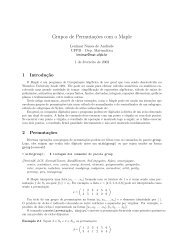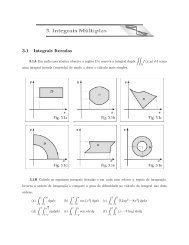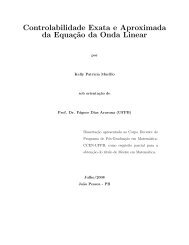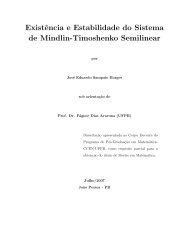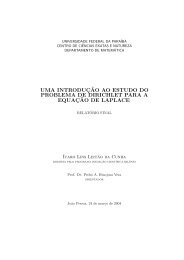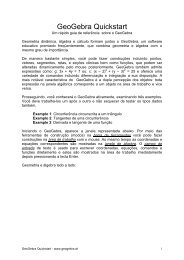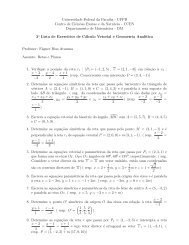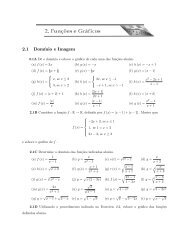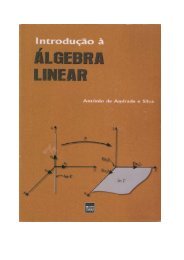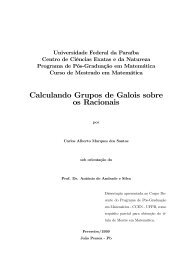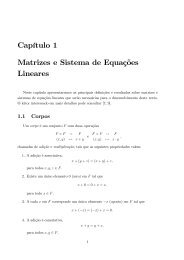Lista de exercícios 2
Lista de exercícios 2
Lista de exercícios 2
You also want an ePaper? Increase the reach of your titles
YUMPU automatically turns print PDFs into web optimized ePapers that Google loves.
2.1 Domínio e Imagem<br />
2.1A Dê o domínio e esboce o grá…co <strong>de</strong> cada uma das funções abaixo.<br />
(a) f (x) = 3x (b) g (x) = x (c) h (x) = x + 1<br />
(d) f (x) = 1 5<br />
3x +<br />
8<br />
< x, se x 2<br />
(g) h (x) =<br />
:<br />
3, se x > 2<br />
x (f) g (x) = jx 1j<br />
8<br />
< 2x, se x 1<br />
(h) h (x) =<br />
(i) h (x) =<br />
:<br />
x + 1, se x > 1<br />
x2 2x + 1<br />
x 1<br />
1<br />
3 (e) g (x) 2<br />
(j) f (x) = jx + 2j + 1 (k) h (x) =<br />
(m) f (x) = jxj<br />
x<br />
(n) g (x) =<br />
j2x + 1j<br />
2x + 1<br />
jx 1j<br />
x 1<br />
(l) h (x) = jx + 2j<br />
(o) g (x) = x2 1<br />
x + 1<br />
2.1B Consi<strong>de</strong>re a função f : R ! R, <strong>de</strong>…nida por f (x) = jx 1j + jx 2j : Mostre que:<br />
8<br />
><<br />
2x + 3, se x 1<br />
f (x) = 1; se 1 < x < 2<br />
>:<br />
2x 3, se x 2<br />
e esboce o grá…co <strong>de</strong> f.<br />
2.1C Determine o domínio das funções indicadas abaixo.<br />
(a) f (x) = 1<br />
(b) y =<br />
x 1<br />
x<br />
x2 (c) s (t) =<br />
1<br />
p t2 1 (d) y = x<br />
x + 2<br />
(e) h (x) = p x + 1<br />
x + 2 (f) q (x) =<br />
x2 r<br />
x 1<br />
(g) r (x) =<br />
(h) y =<br />
+ x<br />
x + 1<br />
4<br />
r<br />
x<br />
x + 3<br />
(i) g (x) = 3p x2 x (j) y = p r<br />
2x 1<br />
x (2 3x) (k) f (x) =<br />
(l) y =<br />
1 3x<br />
6<br />
r<br />
x 3<br />
x + 2<br />
(m) g (x) = 2x<br />
x2 p<br />
x<br />
(n) y =<br />
+ 1<br />
3p<br />
x 1<br />
(o) y = p 4 x 2 (p) y = p 5 2x 2<br />
(q) y = p x 1 + p 3 x (r) y = p 1 p x (s) y = p x p 5 2x (t) y = p x p x<br />
2.1D Utilizando o procedimento indicado no Exercício 2.1B, esboce o grá…co das funções <strong>de</strong>…nidas<br />
abaixo.
COMPLEMENTOS 2 FUNÇÕES E GRÁFICOS 5<br />
(a) f (x) = jxj 1 (b) g (x) = jjxj 1j (c) h (x) = jx + 1j jxj (d) y = x 2 1<br />
2.1E Uma pequena indústria fabrica termômetros e estima que o lucro semanal, em reais, pela<br />
fabricação e venda <strong>de</strong> x unida<strong>de</strong>s/semana é <strong>de</strong> R (x) = 0; 001x 2 + 8x 5000. Qual o lucro da<br />
empresa em uma semana que foram fabricados 1.000 termômetros?<br />
2.1F Determine o domínio da função f (x) =<br />
s<br />
4<br />
3 2x<br />
2 + x :<br />
2.1G Consi<strong>de</strong>re a função f <strong>de</strong>…nida em [ 3; 2] por f (x) = x 3 2x 2 + 3x 4 . Determine dois<br />
números reais m e M tais que m f (x) M, seja qual for o valor <strong>de</strong> x no intervalo [ 3; 2] :<br />
2.1H Consi<strong>de</strong>re a função f : R ! R <strong>de</strong>…nida por f (x) = x 2 + 4x + 5:<br />
(a) Veri…que que f (x) = (x + 2) 2 + 1;<br />
(b) Esboce o grá…co <strong>de</strong> f;<br />
(c) Calcule o menor valor <strong>de</strong> f (x) e para qual x esse valor é assumido.<br />
2.1I Veri…que que p 1 + x 2 jxj =<br />
1<br />
jxj + p e, então, conclua que a medida que x cresce, o<br />
1 + x2 valor da diferença p 1 + x2 jxj aproxima-se <strong>de</strong> zero.<br />
2.1J Seja y = f (x) a função dada a partir da equação x 2 + y 2 = 4, para y 0.<br />
(a) Determine uma fórmula que <strong>de</strong>…na explicitamente y como função <strong>de</strong> x;<br />
(b) Determine o domínio <strong>de</strong> f;<br />
(c) Esboce o grá…co <strong>de</strong> f:<br />
2.1K Uma caixa retangular sem tampa, com volume <strong>de</strong> 2m 3 , tem uma base quadrada. Expresse<br />
a área S da superfície da caixa como uma função do comprimento x <strong>de</strong> um lado da base.<br />
2.1L À medida que o ar seco move-se para cima, ele se expan<strong>de</strong> e esfria. Sabendo-se que a tem-<br />
peratura do solo é <strong>de</strong> 20 0 C e que a temperatura a 1km <strong>de</strong> altura é <strong>de</strong> 10 0 C, expresse a temperatuta<br />
T , em 0 C, como uma variável <strong>de</strong>pen<strong>de</strong>nte da altura h, medida em km, supondo que um mo<strong>de</strong>lo<br />
baseado em uma função a…m seja apropriado. Qual a temperatura a uma altura <strong>de</strong> 2; 5km?<br />
2.1M Suponha que a …gura abaixo representa gra…camente uma função y = f (x) :
6 CÁLCULO DE UMA VARIÁVEL MARIVALDO P. MATOS<br />
(a) Determine f( 1).<br />
(b) É correta a estimativa 2 < f(2) < 3?<br />
(c) Para quais valores <strong>de</strong> x tem-se f(x) = 2?<br />
(d) Para quantos valores <strong>de</strong> x tem-se f(x) = 0?<br />
(e) Qual o domínio <strong>de</strong> f?<br />
(f) Qual a imagem <strong>de</strong> f ?<br />
2.1N Consi<strong>de</strong>re as funções f e g, cujos grá…cos são representados na …gura abaixo.<br />
(a) Obtenha os valores <strong>de</strong> f( 4) e g(3).<br />
(b) Para quais valores <strong>de</strong> x, f(x) = g(x)?<br />
(c) Estabeleça o domínio e a imagem <strong>de</strong> f.<br />
(d) Estabeleça o domínio e a imagem <strong>de</strong> g.<br />
(e) Para quantos valores <strong>de</strong> x, f(x) = 0?<br />
(f) Para quantos valores <strong>de</strong> x, g(x) = 0?<br />
De…nição Se uma função f satisfaz f (x) = f ( x), para todo x em seu domínio, então f<br />
é <strong>de</strong>nominada função par. Se f satisfaz f (x) = f ( x), para todo x em seu domínio, então f é<br />
<strong>de</strong>nominada uma função ímpar.<br />
2.1O Com base na <strong>de</strong>…nição acima, classi…que cada uma das funções abaixo.<br />
(a) f (x) = x 3 (b) g (x) = x 2 (c) h (x) = 2x x 2 (d) k (x) = 1 x 4 (e) f (x) = jxj :<br />
2.1P Dada uma função f; <strong>de</strong>…nida em R ou em um intervalo ( a; a), mostre que g (x) = f (x) +<br />
f ( x) é uma função par e que h (x) = f (x) f ( x) é uma função ímpar. Deduza a partir daí que<br />
qualquer função f; <strong>de</strong>…nida em um intervalo ( a; a) ; po<strong>de</strong> ser expressa como soma <strong>de</strong> uma função<br />
par com uma função ímpar.<br />
De…nição As funções f : A ! B e g : A 0 ! B 0 são iguais quando A = A 0 ; B = B 0 e<br />
f (x) = g (x), 8x 2 A:<br />
2.1Q Diga se f e g são iguais em cada um dos casos abaixo.
COMPLEMENTOS 2 FUNÇÕES E GRÁFICOS 7<br />
(a) f (x) = p x p x 1 e g (x) = p x 2 x (b) f (x) = x 2 e g (x) = jxj 2<br />
(c) f (x) = x2 1<br />
x 1 e g (x) = x + 1 (d) f (x) = x e g (x) = p x 2<br />
2.1R Determine a função quadrática f que satisfaz f (0) = 5; f ( 1) = 10 e f (1) = 6:<br />
De…nição Uma função f é crescente em um intervalo I, se dados x1; x2 2 I, com x1 < x2,<br />
tem-se f (x1) < f (x2). Se f (x1) f (x2), para x1 < x2, então f é dita não-<strong>de</strong>crescente em I:<br />
De…nição Uma função f é <strong>de</strong>crescente em um intervalo I, se dados x1; x2 2 I, com x1 < x2;<br />
tem-se f (x1) > f (x2). Se f (x1) f (x2), para x1 < x2, então f é dita não-crescente em I:<br />
2.1S Mostre que a função a…m f (x) = ax + b é crescente, se a > 0, e <strong>de</strong>crescente, se a < 0:<br />
2.1T Com relação ao grá…co apresentado no Exercício 2.1M, i<strong>de</strong>nti…que o conjunto no qual f é<br />
uma função crescente.<br />
Função Composta Consi<strong>de</strong>re duas funções f e g tais que a imagem <strong>de</strong> f seja um subb-<br />
conjunto do domínio <strong>de</strong> g, isto é, Im (f) D (g). Denominamos <strong>de</strong> composta <strong>de</strong> g e f, e anotamos<br />
g f, a função com domínio D (f) e <strong>de</strong>…nida por: (g f) (x) = g (f (x)), com x 2 D (f) :<br />
2.1U Nos casos a seguir, veri…que que Im (f) D (g) para, assim, <strong>de</strong>terminar a função composta<br />
h = g f:<br />
x + 1<br />
x 2<br />
x + 1<br />
e g (x) =<br />
x 1<br />
(a) f (x) = x 2 e g (x) = p x (b) f (x) = x 2 + 3 e g (x) =<br />
(c) f (x) = p x e g (x) = p 2 x (d) f (x) = x<br />
x + 1<br />
2.1V Determine a função f <strong>de</strong> modo que (g f) (x) = x, 8x 2 D (f), on<strong>de</strong>:<br />
(a) g (x) =<br />
x + 2<br />
x + 1<br />
(b) g (x) = x 2 2x, <strong>de</strong>…nida para x 1:<br />
2.1W Consi<strong>de</strong>re f uma função par e seja h = g f. Mostre que h é uma função par. E se f for<br />
uma função ímpar, po<strong>de</strong>-se a…rmar que h também o será?<br />
2.2 Invertendo uma Função Real<br />
Função Injetora Diz-se que uma função f é injetora (ou injetiva) se dado y 2 Im (f),<br />
existe um único x 2 D (f) tal que y = f (x) : Isto é equivalente a: f (x1) = f (x2) =) x1 = x2:
8 CÁLCULO DE UMA VARIÁVEL MARIVALDO P. MATOS<br />
Função Sobrejetora Diz-se que f : D (f) ! B é sobrejetora (ou sobrejetiva) se<br />
Im (f) = B, isto é, dado y 2 B; existe x 2 D (f) tal que y = f (x) :<br />
Função Bijetora Diz-se que uma função f é bijetora (ou bijetiva) quando for, simul-<br />
taneamente, injetora e sobrejetora. Neste caso, temos:<br />
f : D (f) ! Im (f)<br />
x 7 ! f (x) = y<br />
e po<strong>de</strong>mos <strong>de</strong>…nir a função g : Im (f) ! D (f) ; inversa <strong>de</strong> f; do modo seguinte:<br />
y = f (x) , x = g (y) :<br />
A função g; inversa <strong>de</strong> f; é caracterizada por: (f g) (y) = y e (g f) (x) = x: É comum representar<br />
a função inversa <strong>de</strong> f por f 1 :<br />
2.2A Veri…que que a função f : R ! R <strong>de</strong>…nida por f (x) = 3x + 5 é bijetora e <strong>de</strong>termine sua<br />
inversa.<br />
2.2B Consi<strong>de</strong>re a função do exercício prece<strong>de</strong>nte e <strong>de</strong>termine a inversa da função f f 1 :<br />
2.2C Dê domínio e contra-domínio a<strong>de</strong>quados à função f (x) = x 2 , <strong>de</strong> modo que a mesma seja<br />
invertível e <strong>de</strong>termine a sua inversa.<br />
2.2D Consi<strong>de</strong>re a função f (x) = k=x, on<strong>de</strong> k é uma constante. É necessário impor alguma<br />
restrição à constante k para que f seja invertível? Quem é f 1 ?<br />
2.2E Consi<strong>de</strong>re f : [1=2; +1) ! [b; +1) <strong>de</strong>…nida por f (x) = x 2 x + 1: Qual o valor <strong>de</strong> b que<br />
torna f invertível? Quem é f 1 ? Esboce o grá…co <strong>de</strong> f 1 :<br />
Respostas & Sugestões<br />
2.1A As funções apresentadas em (a), (b), (c), (d), (e), (f), (g), (h), (j) e (l) têm para domínio<br />
o conjunto R dos numeros reais. Por outro lado, temos: (i) R f1g e h (x) = x + 1; se x 6= 1<br />
k) R f 1=2g (m) R f0g (n) R f1g (o) R f 1g e g (x) = x 1, se x 6= 1 2.1C<br />
(a) R f1g (b) R f 1; 1g (c) ( 1; 1)[[1; +1) (d) R f 2g (e) [ 2; +1) (f) R f 1; 0g
COMPLEMENTOS 2 FUNÇÕES E GRÁFICOS 9<br />
(g) ( 1; 1)[[1; +1) (h) ( 1; 3)[[0; +1) (i) R (j) [0; 2=3] (k) (1=3; 1=2] (l) ( 1; 2)[<br />
q<br />
5<br />
[3; +1) (m) R (n) [0; +1) f1g (o) [ 2; 2] (p) [ 2 ;<br />
q<br />
5<br />
2 ] (q) [1; 3] (r) [0; 1] (s) [0; 5=2]<br />
(t) [1; +1) [ f0g 2.5 R$2.000,00 2.6 D (f) = R ( 11=2; 5=6) 2.1G M = 58 e<br />
m = 0 2.1H (c) 1; x = 2 2.1J (a) y = p 4 x 2 (b) [ 2; 2] 2.1K S (x) = x 2 +<br />
8=x 2.1L T (h) = 10h+20; T (2; 5) = 5 0 C 2.1M (a) 4 (b) sim (c) x = 3; x =<br />
1 (d) para dois valores (e) [ 3; 3] (f) [ 4; 4] 2.1N (a) f ( 4) = 2; g (3) = 3 (b) x =<br />
2; x = 2 (c) D (f) = [ 4; 4] ; Im (f) = [ 2; 3] (d) D (g) = [ 4; 3] ; Im (g) = [1=2; 3] (e) para<br />
dois valores (f) nenhum 2.1O (a) ímpar (b) par (c) nem par nem ímpar (d) par (e) par<br />
2.1P As funções f e g são iguais apenas no caso (b) 2.1Q f (x) = 3x 2 2x + 5 2.1S A<br />
função f é crescente no intervalo [0; 3] 2.21 (a) Im (f) = D (g) = [0; +1) e h (x) = jxj (b)<br />
Im (f) = [3; +1) D (g) = R f2g e h (x) = x2 + 4<br />
x2 + 1<br />
h (x) =<br />
(c) Im (f) = ( 1; 0) D (g) = ( 1; 2] e<br />
p 2 + p x; x > 0 (d) Im (f) = D (g) = R f1g e h (x) = 2x 1; x 6= 1 2.1T<br />
x<br />
(a) f (x) =<br />
1<br />
2<br />
x (b) f (x) = 1 + p 1 + x 2.1U Po<strong>de</strong>mos concluir que h é uma função<br />
ímpar, se f e g o forem 2.2A f 1 (x) = 1<br />
3 (x 5) 2.2B f f 1 : R ! R, dada por<br />
f f 1 (x) = x 2.2C D (f) = CD (f) = [0; +1) e f 1 (x) = p x 2.2D k 6= 0 e<br />
f 1 = f 2.2E b = 3=4. A inversa é a função g : [3=4; +1) ! [1=2; +1), <strong>de</strong>…nida por<br />
g (y) = 1<br />
2 +<br />
q<br />
y 3<br />
4



